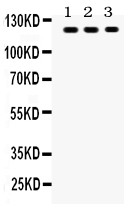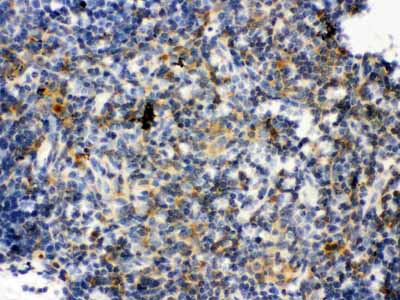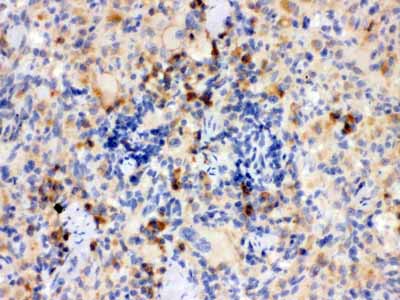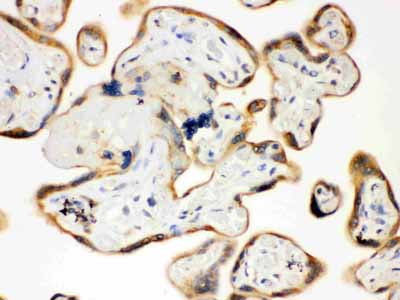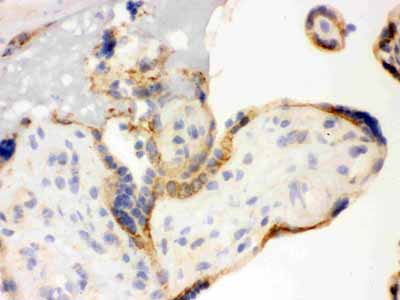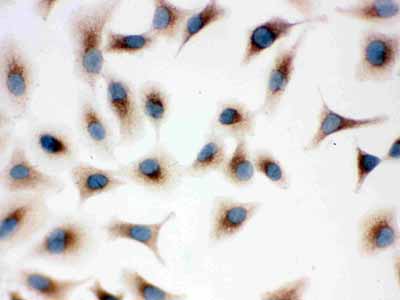Anti-TLR7 Picoband Antibody
- SPECIFICATION
- CITATIONS
- PROTOCOLS
- BACKGROUND

Application
| WB, IHC-P, IHC-F, ICC |
|---|---|
| Primary Accession | Q9NYK1 |
| Host | Rabbit |
| Reactivity | Human, Mouse, Rat |
| Clonality | Polyclonal |
| Format | Lyophilized |
| Description | Rabbit IgG polyclonal antibody for Toll-like receptor 7(TLR7) detection. Tested with WB, IHC-P, IHC-F, ICC in Human;Mouse;Rat. |
| Reconstitution | Add 0.2ml of distilled water will yield a concentration of 500ug/ml. |
| Gene ID | 51284 |
|---|---|
| Other Names | Toll-like receptor 7, TLR7 |
| Calculated MW | 120922 MW KDa |
| Application Details | Immunohistochemistry(Paraffin-embedded Section), 0.5-1 µg/ml, Human, Mouse, Rat, By Heat Immunocytochemistry , 0.5-1 µg/ml, Human, - Immunohistochemistry(Frozen Section), 0.5-1 µg/ml, Human, - Western blot, 0.1-0.5 µg/ml, Human |
| Subcellular Localization | Endoplasmic reticulum membrane ; Single-pass type I membrane protein . Endosome . Lysosome . Cytoplasmic vesicle, phagosome. Relocalizes from endoplasmic reticulum to endosome and lysosome upon stimulation with agonist. . |
| Tissue Specificity | Detected in brain, placenta, spleen, stomach, small intestine, lung and in plasmacytoid pre-dendritic cells. |
| Protein Name | Toll-like receptor 7 |
| Contents | Each vial contains 5mg BSA, 0.9mg NaCl, 0.2mg Na2HPO4, 0.05mg NaN3. |
| Immunogen | A synthetic peptide corresponding to a sequence at the C-terminus of human TLR7 (1020-1047aa QAHPYFWQCLKNALATDNHVAYSQVFKE), different from the related mouse sequence by two amino acids. |
| Purification | Immunogen affinity purified. |
| Cross Reactivity | No cross reactivity with other proteins |
| Storage | At -20˚C for one year. After r˚Constitution, at 4˚C for one month. It˚Can also be aliquotted and stored frozen at -20˚C for a longer time.Avoid repeated freezing and thawing. |
| Sequence Similarities | Belongs to the Toll-like receptor family. |
| Name | TLR7 (HGNC:15631) |
|---|---|
| Function | Endosomal receptor that plays a key role in innate and adaptive immunity (PubMed:14976261, PubMed:32433612). Controls host immune response against pathogens through recognition of uridine- containing single strand RNAs (ssRNAs) of viral origin or guanosine analogs (PubMed:12738885, PubMed:27742543, PubMed:31608988, PubMed:32706371, PubMed:35477763). Upon binding to agonists, undergoes dimerization that brings TIR domains from the two molecules into direct contact, leading to the recruitment of TIR-containing downstream adapter MYD88 through homotypic interaction (PubMed:27742543). In turn, the Myddosome signaling complex is formed involving IRAK4, IRAK1, TRAF6, TRAF3 leading to activation of downstream transcription factors NF-kappa-B and IRF7 to induce pro-inflammatory cytokines and interferons, respectively (PubMed:27742543, PubMed:32706371). In plasmacytoid dendritic cells, RNASET2 endonuclease cooperates with PLD3 or PLD4 5'->3' exonucleases to process RNA and release 2',3'-cyclic guanosine monophosphate (2',3'-cGMP) and cytidine-rich RNA fragments that occupy TLR7 ligand-binding pockets and trigger a signaling- competent state. |
| Cellular Location | Endoplasmic reticulum membrane {ECO:0000250|UniProtKB:P58681}; Single-pass type I membrane protein {ECO:0000250|UniProtKB:P58681}. Endosome {ECO:0000250|UniProtKB:P58681}. Lysosome {ECO:0000250|UniProtKB:P58681}. Cytoplasmic vesicle, phagosome {ECO:0000250|UniProtKB:P58681}. Note=Relocalizes from endoplasmic reticulum to endosome and lysosome upon stimulation with agonist {ECO:0000250|UniProtKB:P58681} |
| Tissue Location | Detected in brain, placenta, spleen, stomach, small intestine, lung and in plasmacytoid pre-dendritic cells. Expressed in peripheral mononuclear blood cells (PubMed:32706371) |

Thousands of laboratories across the world have published research that depended on the performance of antibodies from Abcepta to advance their research. Check out links to articles that cite our products in major peer-reviewed journals, organized by research category.
info@abcepta.com, and receive a free "I Love Antibodies" mug.
Provided below are standard protocols that you may find useful for product applications.
Background
TLR7 (Toll-like receptor 7) is protein that in humans is encoded by the TLR7 gene. Orthologs are found in mammals and birds. TLR7 is a member of the Toll-like receptor (TLR) family which plays a fundamental role in pathogen recognition and activation of innate immunity. TLRs are highly conserved from Drosophila to humans and share structural and functional similarities. They recognize pathogen-associated molecular patterns (PAMPs) that are expressed on infectious agents, and mediate the production of cytokines necessary for the development of effective immunity. The various TLRs exhibit different patterns of expression. This gene is predominantly expressed in lung, placenta, and spleen, and lies in close proximity to another family member, TLR8, on human chromosome X. TLR7 recognises single stranded RNA in endosomes, which is a common feature of viral genomes which are internalised by macrophages.
If you have used an Abcepta product and would like to share how it has performed, please click on the "Submit Review" button and provide the requested information. Our staff will examine and post your review and contact you if needed.
If you have any additional inquiries please email technical services at tech@abcepta.com.













 Foundational characteristics of cancer include proliferation, angiogenesis, migration, evasion of apoptosis, and cellular immortality. Find key markers for these cellular processes and antibodies to detect them.
Foundational characteristics of cancer include proliferation, angiogenesis, migration, evasion of apoptosis, and cellular immortality. Find key markers for these cellular processes and antibodies to detect them. The SUMOplot™ Analysis Program predicts and scores sumoylation sites in your protein. SUMOylation is a post-translational modification involved in various cellular processes, such as nuclear-cytosolic transport, transcriptional regulation, apoptosis, protein stability, response to stress, and progression through the cell cycle.
The SUMOplot™ Analysis Program predicts and scores sumoylation sites in your protein. SUMOylation is a post-translational modification involved in various cellular processes, such as nuclear-cytosolic transport, transcriptional regulation, apoptosis, protein stability, response to stress, and progression through the cell cycle. The Autophagy Receptor Motif Plotter predicts and scores autophagy receptor binding sites in your protein. Identifying proteins connected to this pathway is critical to understanding the role of autophagy in physiological as well as pathological processes such as development, differentiation, neurodegenerative diseases, stress, infection, and cancer.
The Autophagy Receptor Motif Plotter predicts and scores autophagy receptor binding sites in your protein. Identifying proteins connected to this pathway is critical to understanding the role of autophagy in physiological as well as pathological processes such as development, differentiation, neurodegenerative diseases, stress, infection, and cancer.
